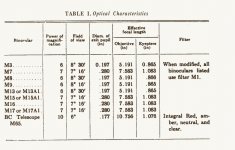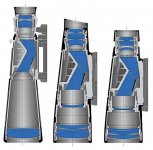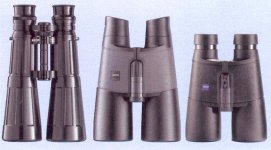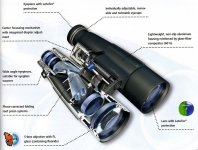John A Roberts
Well-known member

I recently posted a link to the Ordnance Maintenance Manual TM 9-1580 which dates from 1953, for use by the US Army and US Air Force.
It covers the M3 through M17A1 binoculars, along with the M65 telescope (a periscope style binoviewer).
See post #11 at: Nikon Venturer II Collimation
The first table in the manual shows the effective focal lengths of the objectives and eye pieces - something not often listed for binoculars.
As magnification is the ratio of the two focal lengths, binoculars of significantly different physical lengths can have the same magnification.
See an image of three 8x56 Zeiss models (all using Abbe-Koenig prisms):
• the 1968 Classic - 237 mm/ 9.3” long
• the 1992 Design Selection - 214 mm/ 8.5”
• the 2000 Victory (pre-FL) - 197 mm/ 7.8”
(and also with A-K prisms are both: the more recent Victory FL - 200 mm/ 7.9”; and the current 8x54 HT - 193 mm/ 7.6”)
The Classic was based on an earlier Hensoldt design but with a modified eyepiece for increased eye relief. While it has a significantly narrower FOV,
it is known for high optical performance (and it continued to be offered until 2016!).
The image demonstrates that things like increased FOV and compactness, along with internal focus, are all possible while maintaining optical performance.
However, the costs include more complex optical designs with increased glass volume (along with the use of more exotic glass), and so increased weight.
For more information, see the paper dating from 2000 by the late Walter Besenmatter at: Zeiss 8x56 Technical Considerations - by Zeiss
In terms of the practicalities of optical design, Roger Cicala recently detailed the conflicting demands of the 'lens design triangle' of cost vs size vs quality.
See at: Some things that manufacturers consider in choosing to make a binocular
And to illustrate what’s needed to achieve a dramatic increase in optical performance, compare the $6.4k Nikon WX 10x50 to the $2.9k Swarovski EL 10x50.
The prices are from the US site BH Photo, and the image is from hk112 at: Nikon WX experience - Binoculars - Cloudy Nights
John
It covers the M3 through M17A1 binoculars, along with the M65 telescope (a periscope style binoviewer).
See post #11 at: Nikon Venturer II Collimation
The first table in the manual shows the effective focal lengths of the objectives and eye pieces - something not often listed for binoculars.
As magnification is the ratio of the two focal lengths, binoculars of significantly different physical lengths can have the same magnification.
See an image of three 8x56 Zeiss models (all using Abbe-Koenig prisms):
• the 1968 Classic - 237 mm/ 9.3” long
• the 1992 Design Selection - 214 mm/ 8.5”
• the 2000 Victory (pre-FL) - 197 mm/ 7.8”
(and also with A-K prisms are both: the more recent Victory FL - 200 mm/ 7.9”; and the current 8x54 HT - 193 mm/ 7.6”)
The Classic was based on an earlier Hensoldt design but with a modified eyepiece for increased eye relief. While it has a significantly narrower FOV,
it is known for high optical performance (and it continued to be offered until 2016!).
The image demonstrates that things like increased FOV and compactness, along with internal focus, are all possible while maintaining optical performance.
However, the costs include more complex optical designs with increased glass volume (along with the use of more exotic glass), and so increased weight.
For more information, see the paper dating from 2000 by the late Walter Besenmatter at: Zeiss 8x56 Technical Considerations - by Zeiss
In terms of the practicalities of optical design, Roger Cicala recently detailed the conflicting demands of the 'lens design triangle' of cost vs size vs quality.
See at: Some things that manufacturers consider in choosing to make a binocular
And to illustrate what’s needed to achieve a dramatic increase in optical performance, compare the $6.4k Nikon WX 10x50 to the $2.9k Swarovski EL 10x50.
The prices are from the US site BH Photo, and the image is from hk112 at: Nikon WX experience - Binoculars - Cloudy Nights
John
Attachments
Last edited:








